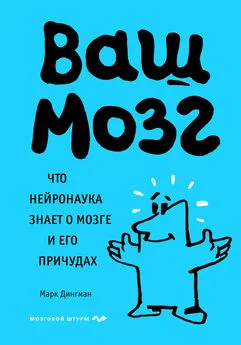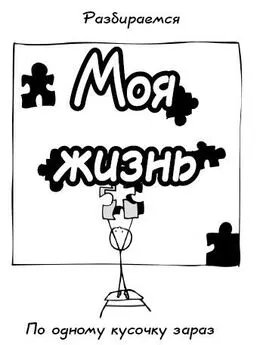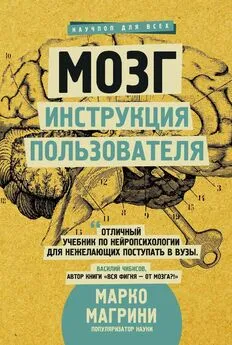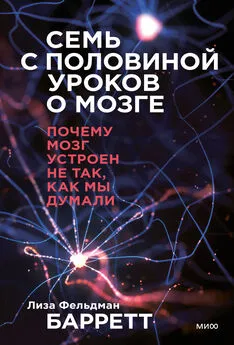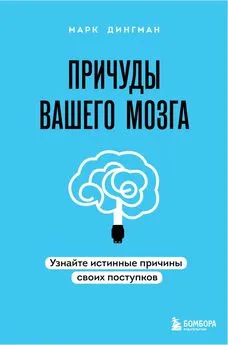Марк Дингман - Ваш мозг. Что нейронаука знает о мозге и его причудах
- Название:Ваш мозг. Что нейронаука знает о мозге и его причудах
- Автор:
- Жанр:
- Издательство:Эксмо
- Год:2020
- Город:Москва
- ISBN:978-5-04-115480-6
- Рейтинг:
- Избранное:Добавить в избранное
-
Отзывы:
-
Ваша оценка:
Марк Дингман - Ваш мозг. Что нейронаука знает о мозге и его причудах краткое содержание
Ваш мозг. Что нейронаука знает о мозге и его причудах - читать онлайн бесплатно ознакомительный отрывок
Интервал:
Закладка:
Примечания
Введение
1.K. Goldstein, “Zur Lehre von der Motorischen Apraxie,” Journal fur Psychologie und Neurologie 11, no. 4/5 (1908): 270–283.
Глава 1
1.R. Adolphs, D. Tranel, H. Damasio, and A. Damasio, “Impaired Recognition of Emotion in Facial Expressions Following Bilateral Damage to the Human Amygdala,” Nature 372, no. 6507 (December 1994): 669–672.
2.J.S. Feinstein, R. Adolphs, A. Damasio, and D. Tranel, “The Human Amygdala and the Induction and Experience of Fear,” Current Biology 21, no. 1 (January 2011): 34–38.
3.Там же.
4.C.M. Schumann and D.G. Amaral, “Stereological Estimation of the Number of Neurons in the Human Amygdaloid Complex,” Journal of Comparative Neurology 491, no. 4 (October 2005): 320–329.
5.D.J. Lanska, “The Kluver-Bucy Syndrome,” Frontiers of Neurology and Neuroscience 41 (2018): 77–89.
6.H. Kluver, P. Bucy, “An Analysis of Certain Effects of Bilateral Temporal Lobectomy in the Rhesus Monkey, with Special Reference to ‘Psychic Blindness,’” The Journal of Psychology 5, no. 1 (January 1938): 33–54.
7.Несмотря на то, что эксперименты Клювера и Бьюси широко известны, еще до них исследователи наблюдали похожие изменения в поведении животных после повреждения височной доли. Браун и Шефер опередили Клювера и Бьюси примерно на полвека. См. S. Brown and E. Schafer, “An Investigation into the Functions of the Occipital and Temporal Lobes of the Monkey’s Brain,” Philosophical Transactions of the Royal Society B 179 (1888): 303–327.
8.L. Weiskrantz, “Behavioral Changes Associated with Ablation of the Amygdaloid Complex in Monkeys,” Journal of Comparative and Physiological Psychology 49, no. 4 (August 1956): 381–391.
9.J.E. LeDoux, P. Cicchetti, A. Xagoraris, and L.M. Romanski, “The Lateral Amygdaloid Nucleus: Sensory Interface of the Amygdala in Fear Conditioning,” Journal of Neuroscience 10, no. 4 (April 1990): 1062–1069.
10.G.J. Quirk, C. Repa, and J.E. LeDoux, “Fear Conditioning Enhances Short-Latency Auditory Responses of Lateral Amygdala Neurons: Parallel Recordings in the Freely Behaving Rat,” Neuron 15, no. 5 (November 1995): 1029–1039.
11.K.S. LaBar, J.C. Gatenby, J.C. Gore, J.E. LeDoux, and E.A. Phelps, “Human Amygdala Activation during Conditioned Fear Acquisition and Extinction: A Mixed-Trial fMRI Study,” Neuron 20, no. 5 (May 1998): 937–945.
12.D. Mobbs, R. Yu, J.B. Rowe, H. Eich, O. Feldman Hall, and T. Dalgleish, “Neural Activity Associated with Monitoring the Oscillating Threat Value of a Tarantula,” Proceedings of the National Academy of Sciences of the United States of America 107, no. 47 (November 2010): 20582-20586.
13.PJ. Whalen, S.L. Rauch, N.L. Etcoff, S.C. McInerney, M.B. Lee, and M.A. Jenike, “Masked Presentations of Emotional Facial Expressions Modulate Amygdala Activity without Explicit Knowledge,” Journal of Neuroscience 18, no. 1 (January 1998): 411–418.
14.“Юристы Бостона”, серия “Attack of the Xenophobes”. Режиссер Дж. Терлески, сценаристы Д. Келли и К. Турк. 20th Century Fox Television, 13 ноября, 2007.
15.“Первый Мститель: Противостояние”. Режиссеры Э. Руссо и Дж. Руссо. Marvel Studios, 2016.
16.M. Gallagher, P.W. Graham, and P.C. Holland, “The Amygdala Central Nucleus and Appetitive Pavlovian Conditioning: Lesions Impair One Class of Conditioned Behavior,” Journal of Neuroscience 10, no. 6 (June 1990): 1906–1911.
17.J.S. Feinstein, C. Buzza, R. Hurlemann, R.L. Follmer, N.S. Dah-daleh, W.H. Coryell, M.J. Welsh, D. Tranel, and J.A. Wemmie, “Fear and Panic in Humans with Bilateral Amygdala Damage,” Nature Neuroscience 16, no. 3 (March 2013): 270–272.
18.B. Becker, Y. Mihov, D. Scheele, K.M. Kendrick, J.S. Feinstein, A. Matusch, M. Aydin, et al., “Fear Processing and Social Networking in the Absence of a Functional Amygdala,” Biological Psychiatry 72, no. 1 (July 2012): 70–77.
19.S.A. Freedman, H.G. Hoffman, A. Garcia-Palacios, P.L. Tamar Weiss, S. Avitzour, and N. Josman, “Prolonged Exposure and Virtual Reality-Enhanced Imaginal Exposure for PTSD Following a Terrorist Bulldozer Attack: A Case Study,” Cyberpsychology, Behavior, and Social Networking 13, no. 1 (February 2010): 95-101.
20.I. Liberzon, S.F. Taylor, R. Amdur, T.D. Jung, K.R. Chamberlain, S. Minoshima, R.A. Koeppe, and L.M. Fig, “Brain Activation in PTSD in Response to Trauma-Related Stimuli,” Biological Psychiatry 45, no. 7 (April 1999): 817–826.
21L.M. Shin, C.I. Wright, P.A. Cannistraro, M.M. Wedig, K. McMullin, B. Martis, M.L. Macklin, et al., “A Functional Magnetic Resonance Imaging Study of Amygdala and Medial Prefrontal Cortex Responses to Overtly Presented Fearful Faces in Posttraumatic Stress Disorder,” Archives of General Psychiatry 62, no. 3 (March 2005): 273–281.
Глава 2
1.E.S. Parker, L. Cahill, and J.L. McGaugh, “A Case of Unusual Autobiographical Remembering” Neurocase 12, no. 1 (February 2006): 35–49.
2.Там же.
3.Там же.
4.Там же.
5.S. Dice, “Aplysia californica” University of Michigan Museum of Zoology, last modified 2014, https://animaldiversity.org/accounts/ Aplysia_californica/.
6. D. Wearing, Forever Today: A Memoir of Love and Amnesia (London: Double-day, 2005).
7.M.A. Wilson and B.L. McNaughton, “Reactivation of Hippocampal Ensemble Memories during Sleep” Science 265, no. 5172 (July 1994): 676–679.
8.Centers for Disease Control and Prevention, “Life Expectancy at Birth, by Race and Sex, Selected Years 1929-98” National Vital Statistics Reports 50, no. 6 (August 2017): 1-64.
9.Alzheimer’s Association, “2018 Alzheimer’s Disease Facts and Figures,” Alzheimer’s & Dementia 14, no. 3 (2018): 367–429.
10.G. Chene, A. Beiser, R. Au, S.R. Preis, P.A. Wolf, C. Dufouil, and S. Seshadri, “Gender and Incidence of Dementia in the Framingham Heart Study from Mid-Adult Life,” Alzheimer’s & Dementia 11, no.
3 (March 2015): 310–320.
11.D.J. Simons, W.R. Boot, N. Charness, S.E. Gathercole, C.F. Chab-ris, D.Z. Hambrick, and E.A. Stine-Morrow, “Do ‘Brain-Training’ Programs Work?” Psychological Science in the Public Interest 17, no. 3 (October 2016): 103–186.
12.H. Forstl and A. Kurz, “Clinical Features of Alzheimer’s Disease,” European Archives of Psychiatry and Clinical Neuroscience 249, no. 6 (December 1999): 288–290.
13.P. Giannakopoulos, F.R. Herrmann, T. Bussiere, C. Bouras, E. Kovari, D.P. Perl, J.H. Morrison, G. Gold, P.R. Hof, “Tangle and Neuron Numbers, but Not Amyloid Load, Predict Cognitive Status in Alzheimer’s Disease,” Neurology 60, no. 9 (May 2003): 1495-500.
Глава 3
1.E. Lugaresi, R. Medori, P. Montagna, A. Baruzzi, P. Cortelli, A. Lugaresi, P. Tinuper, M. Zucconi, and P. Gambetti, “Fatal Familial Insomnia and Dysautonomia with Selective Degeneration of Thalamic Nuclei,” New England Journal of Medicine 315, no. 16 (October 1986): 997-1003.
2.L. Cracco, B.S. Appleby, and P. Gambetti, “Fatal Familial Insomnia and Sporadic Fatal Insomnia,” Handbook of Clinical Neurology 153 (2018): 271–299.
3.L. Xie, H. Kang, Q. Xu, M.J. Chen, Y. Liao, M. Thiyagarajan, J. O’Donnell, et al., “Sleep Drives Metabolite Clearance from the Adult Brain,” Science 342, no. 6156 (October 2013): 373–377.
4.R. Ginzberg, “Three Years with Hans Berger: A Contribution to His Biography,” Journal of the History of Medicine and Allied Sciences 4, no. 1 (1949): 361–371.
5.D. Millett, “Hans Berger: From Psychic Energy to the EEG,” Perspectives in Biology and Medicine 44, no. 4 (Fall 2001): 522–542.
6. L. Leclair-Visonneau, D. Oudiette, B. Gaymard, S. Leu-Semenescu, and I. Arnulf, “Do the Eyes Scan Dream Images during Rapid Eye Movement Sleep? Evidence from the Rapid Eye Movement Sleep Behaviour Disorder Model,” Brain 133, no. 6 (June 2010): 1737–1746.
7.C.D. Clemente and M.B. Sterman, “Limbic and Other Forebrain Mechanisms in Sleep Induction and Behavioral Inhibition,” Progress in Brain Research 27 (1967): 34–47.
8.M.J. McGinty and M.B. Sterman, “Sleep Suppression After Basal Forebrain Lesions In the Cat,” Science 160, no. 3833 (June 1968): 1253–1255.
9.G. Moruzzi, H.W Magoun, “Brain Stem Reticular Formation and Activation of the EEG,” The Journal of Neuropsychiatry and Clinical Neurosciences 7, no. 2 (Spring 1995): 251–267.
10.H.H. Webster and B.E. Jones, “Neurotoxic Lesions of the Dorsolateral Pontomesencephalic Tegmentum-Cholinergic Cell Area in the Cat. II. Effects upon Sleep-Waking States,” Brain Research 458, no. 2 (August 1988): 285–302.
11M. Thakkar, C. Portas, and R.W. McCarley, “Chronic Low-Amplitude Electrical Stimulation of the Laterodorsal Tegmental Nucleus of Freely Moving Cats Increases REM Sleep,” Brain Research 723, no. 1–2 (June 1996): 223–227.
12.L. Lin, J. Faraco, R. Li, H. Kadotani, W Rogers, X. Lin, X. Qiu, PJ. de Jong, S. Nishino, and E. Mignot, “The Sleep Disorder Canine Narcolepsy Is Caused by a Mutation in the Hypocretin (Orexin) Receptor 2 Gene,” Cell 98, no. 3 (August 1999): 365–376.
13.T.C. Thannickal, R.Y. Moore, R. Nienhuis, L. Ramanathan, S. Gu-lyani, M. Aldrich, M. Cornford, J.M. Siegel, “Reduced Number of Hypocretin Neurons in Human Narcolepsy,” Neuron 27, no. 3 (September 2000): 469-74.
14.A.M. Chang, D. Aeschbach, J.F. Duffy, and C.A. Czeisler, “Evening Use of Light-Emitting Ereaders Negatively Affects Sleep, Circadian Timing, and Next-Morning Alertness,” Proceedings of the National Academy of Sciences of the United States of America 112, no. 4 (January 2015): 1232–1237.
15.F.K. Stephan and I. Zucker, “Circadian Rhythms in Drinking Behavior and Locomotor Activity of Rats are Eliminated by Hypothalamic Lesions,” Proceedings of the National Academy of Sciences of the United States of America 69, no. 6 (June 1972): 1583–1586.
16.D.C. Mitchell, C.A. Knight, J. Hockenberry, R. Teplansky, and T.J. Hartman, “Beverage Caffeine Intakes in the U.S.” Food and Chemical Toxicology 63 (January 2014): 136–142.
17.E.S. Ford, T.J. Cunningham, W.H. Giles, and J.B. Croft, “Trends in Insomnia and Excessive Daytime Sleepiness among U.S. Adults from 2002 to 2012,” Sleep Medicine 16, no. 3 (March 2015): 372378.
18.A. Aldridge, J. Bailey, and A.H. Neims, “The Disposition of Caffeine during and after Pregnancy,” Seminars in Perinatology 5, no. 4 (October 1981): 310–314.
19.C. Drake, T. Roehrs, J. Shambroom, and T. Roth, “Caffeine Effects on Sleep Taken 0, 3, or 6 Hours before Going to Bed,” Journal of Clinical Sleep Medicine 9, no. 11 (November 2013): 1195–1200.
20.E. Ferracioli-Oda, A. Qawasmi, and M.H. Bloch, “Meta-Analysis: Melatonin for the Treatment of Primary Sleep Disorders,” PLoS One 8, no. 5 (May 2013): e63773.
21.H.P. Landolt, E. Werth, A.A. Borbely, and D.J. Dijk, “Caffeine Intake (200 Mg) in the Morning Affects Human Sleep and EEG Power Spectra at Night,” Brain Research 675, no. 1–2 (March 1995): 67–74.
Глава 4
1.M. Takeda, H. Tachibana, N. Shibuya, Y. Nakajima, B. Okuda, M. Sugita, and H. Tanaka, “Pure Anomic Aphasia Caused by a Subcortical Hemorrhage in the Left Temporo-Parieto-Occipital Lobe,” Internal Medicine Journal 38, no. 3 (March 1999): 293–295.
Читать дальшеИнтервал:
Закладка:
